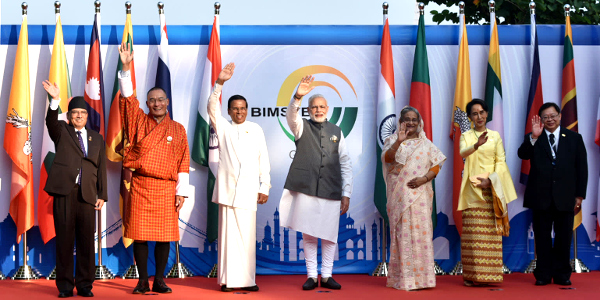Returned to the saddle earlier this month with a massive mandate, the Narendra Modi-led NDA government’s second innings is starting off with the according of primacy to the BIMSTEC (Bay of Bengal Initiative for Multi-Sectoral Technical and Economic Cooperation) effort.
This is a paradigm shift from the priority accorded to the SAARC initiative when the BJP first took the cudgels of power in June 2014. It has huge implications on the insurgency situation in India’s Northeast, a region that is the gateway to a successful perusal of economic relation with the countries in the East.
In keeping with the shift, leaders of BIMSTEC nations — Bangladesh, Myanmar, Sri Lanka, Thailand, Nepal and Bhutan — are invitees to the new government’s swearing-in ceremony in New Delhi. The SAARC initiative included Pakistan (and Afghanistan).
This development can be seen as a policy juxtaposition of sorts where India’s ‘Neighbourhood First’ policy blends in perfectly with the Act East Policy (AEP) where it is the East, especially Myanmar, that will immensely matter.
The new thrust in the AEP seeks to overcome geographical hurdles in order to strengthen direct links of the insurgency-hit North East region with the rest of India as well as to use the geographical and cultural advantages that the region offers due to its close proximity with the neighbouring countries in the East. The only problem envisaged remains that of security. That is precisely what the Modi government seeks to surmount.
In what can be seen as fitting into a perfect pattern, the developments are taking place even as the Modi government has mounted an unprecedented effort to clear Myanmar’s self-administered Sagaing Division of insurgent outfits who operated from camps set up in the remote jungle areas east of North East India in Myanmar’s northwest.
The east Sagaing area is one where till recently, the presence of the Myanmarese government was more conspicuous in its absence. Endowed with semi-evergreen forests, the undulating terrain offers safe sanctuary to the many armed insurgent outfits from India including NSCN, ULFA, PLA and UNLF to name just a few. It is also an area, the stability and security of which is vital for the infrastructure development plans of the Indian government that is a sine qua non for the success of the AEP.
The insurgents — of both Indian and Myanmarese outfits — maintain the capability to disrupt vital components of the AEP including the ambitious India-Myanmar-Thailand trilateral highway (IMT), the road-river-port cargo Kaladan transport project etc.
In just the past two months, there has been a flurry of high-level Indian visits to Myanmar. The defence secretary, the director general of military operations (DGMO), top Indian military officials have graced the corridors of power in Naypyitaw.
These high-level exchanges have fructified into unprecedented military operations at Ground Zero in east Sagaing. On 29 January, several battalions of the Tatmadaw’s (Myamarese Army) North Western Division Command drove into the NSCN’s general headquarters in Taga, sending the allied outfits into a disarray and confusion. The PLA-UNLF and the ULFA have been forced to relocate after suffering the Tatmadaw’s onslaught. And then on 16 May, another massive operation was mounted in Naga areas near the townships of Lahe and Nanyun.
Teams of the elite Indian Special Forces, based out of Arunachal Pradesh and Nagaland, are learnt to have taken part in the operations although on a smaller scale. And what is being done on the Indian side is to hunt down insurgents trying to relocate due to the Tatmadaw’s operations.
On the other hand, the Indian military had been proactive in ‘obstructing’ Myanmar’s ethnic-Buddhist Arakanese rebels from entering Mizoram during the Tatmadaw’s recent operations. The Arakanese rebels are reported to have used the border areas of Mizoram as safe sanctuaries.
Further, in contrast to the international opinion, the Indian government has been maintaining a stoic silence on the reported Tatmadaw attacks on the Rohingyas in the country’s restive Rakhine province.
The Indian government’s insistence on clamping down on insurgent actors as well as the steady supply of information, weapons and other logistical help has been a key factor in the Tatmadaw’s shedding of its initial reluctance to mount coercive action as its hands were already tied in several other fronts where it has been battling the Shans and the Kachins besides the Arakan rebels.
It is perhaps pertinent to point out what the BJP’s 2019 poll manifesto said. “To extensively leverage forums such as BIMSTEC, to accelerate regional coordination and economic co-operation with countries in our neighbourhood… We will actively pursue co-operation against global evils, such as terrorism … To forward our ‘Neighbourhood First’ policy, we will extensively leverage forums such as BIMSTEC, to accelerate regional coordination and economic co-operation with countries in our neighbourhood,” it read.
With the Naga movement split into fragments, a vastly-weakened ULFA and quiet Meitei insurgents, the NDA-III government may just be sensing that this may be the right time to move in strong with well-laid plans.
Source: FP
Image Courtesy:Nikkie
You may also like
-
IAF Aircraft Set Course For Exercise Eastern Bridge VII At Oman
-
India-us Working Together In Areas Like Critical Minerals, Supply Chains And Advanced Technologies: Shri Piyush Goyal
-
Defence Secretary to co-chair 5th India-Philippines Joint Defence Cooperation Committee meeting in Manila
-
2nd India-Japan Finance Dialogue held in Tokyo on 6th September, 2024
-
Prime Minister, Shri Narendra Modi welcomes Crown Prince of Abu Dhabi
